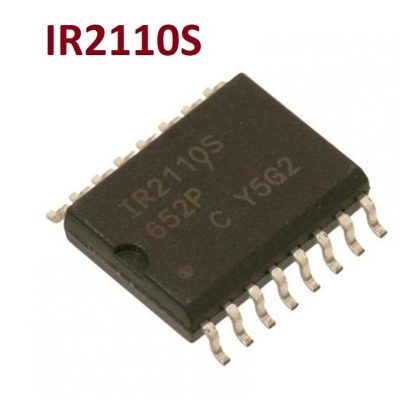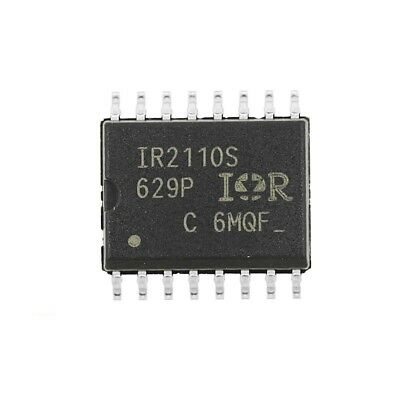IR2110S
Part Number: IR2110S
Manufacturer: Infineon Technologies
Description: MOSFET Driver
Shipped from: Shenzhen/HK Warehouse
Stock Available: Check with us
ICRFQ.com - Electronic Components Distributor in China Since 2003

Part Number: IR2110S
Manufacturer: Infineon Technologies
Description: MOSFET Driver
Shipped from: Shenzhen/HK Warehouse
Stock Available: Check with us
| Datasheet | |
|---|---|
| Category | Integrated Circuits (ICs) |
| Family | PMIC – Gate Drivers |
| Manufacturer | Infineon Technologies |
| Series | – |
| Packaging | Tube |
| Part Status | Obsolete |
| Driven Configuration | Half-Bridge |
| Channel Type | Independent |
| Number of Drivers | 2 |
| Gate Type | IGBT, N-Channel MOSFET |
| Voltage – Supply | 3.3 V ~ 20 V |
| Logic Voltage – VIL, VIH | 6V, 9.5V |
| Current – Peak Output (Source, Sink) | 2A, 2A |
| Input Type | Non-Inverting |
| High Side Voltage – Max (Bootstrap) | 500V |
| Rise / Fall Time (Typ) | 25ns, 17ns |
| Operating Temperature | -40°C ~ 150°C (TJ) |
| Mounting Type | Surface Mount |
| Package / Case | 16-SOIC (0.295″, 7.50mm Width) |
| Supplier Device Package | 16-SOIC |
The IR2110 is a monolithically integrated driver module for high-voltage, high-speed, dual-channel power devices from IR. This bootstrap integrated circuit for power MOSFET and IGBT drive has been improved upon since its introduction due to its small size, low cost, high integration, fast response, high bias voltage, and powerful driving capacity.
They are utilized extensively in domains related to power transmission, particularly those concerned with velocity and power generation. Each pair of MOSFETs (upper and lower) can share a single IR2110. All IR2110s can utilize the same power supply thanks to the IR2110’s superior bootstrap circuitry and level shifting technology, which considerably simplifies the control requirements of logic devices for power devices.
The three IR2110s can be used to power the three bridge arms of a standard three-phase bridge inverter, and just a single 10V20V power source is needed. The engineering complexity of the system is decreased, the number of power sources is minimized, the drive circuit is compacted, and the system’s reliability is enhanced. Let’s get some information on gate drivers before we go any further with the subject.
An IGBT or power MOSFET’s gate can be driven by a gate driver, which functions as a power amplifier by taking a low-power input from a controller IC. There is the option of having gate drivers included on the chip or as a separate module. A gate driver is an amplifier and level shifter. The control signals (analog controllers or digital) and the power switches are connected via a gate driver IC (MOSFETs, IGBTs, GaN HEMTs and SiC MOSFETs). Compared to discretely implemented gate-drive solutions, the benefits of using an integrated gate-driver solution include reduced design complexity, bill of materials (BOM), development time, increased dependability, and board space.
The initial monolithic HVIC gate driver product employed patented and exclusive monolithic topologies integrating CMOS, bipolar, and lateral DMOS devices with breakdown voltages of 700 V and 1400 V, respectively, for 600 V and 1200 V operating offset voltages.
This technology was first introduced by International Rectifier (IR) in 1989.
This HVIC technology can create low-voltage analog and digital circuits in addition to high-voltage level-shifting circuits. High-side power MOSFETs or IGBTs are used in various off-line circuit topologies, including synchronous boost, buck, half-bridge, full-bridge, and three-phase converters. This is due to the fact that they enable the separation of high-voltage circuitry from the rest of the low-voltage circuitry (in a “well” created by polysilicon rings that can “float” 600 V or 1200 V on the same silicon). High-side, half-bridge, and three-phase topologies benefit the HVIC gate drivers’ use of float switches.
In contrast to bipolar transistors, metal-oxide-semiconductor field-effect transistors (MOSFETs) can operate without external power as long as they are not actively conducting—a capacitor forms between the gate-electrode and gate-emitter when a MOSFET is turned on or off. The corresponding gate capacitor must be charged to at least that voltage to turn on a transistor that needs a specific gate voltage. Similarly, dissipating this charge, i.e., discharging the gate capacitor, is required to turn the transistor off.
The transition from the off to the on the state of a transistor is not instantaneous, and the device may momentarily withstand a high voltage and carry a large current. Therefore, heat is generated when a gate current is provided to a transistor to force it to switch; this heat might sometimes be sufficient to damage the transistor. The changeover time must be kept short to reduce switching loss [de]. In most cases, the time it takes to transition is measured in microseconds.
A larger gate-charging current results in a shorter switching time for a transistor; therefore, switching currents in the milliampere or even ampere range are commonly necessary. Many watts of energy may be needed to power the switch at common gate voltages of around 10–15V. In applications where high-frequency switching of large currents is required, such as in DC-to-DC converters or big electric motors, many transistors are sometimes provided in parallel to ensure adequate switching currents and switching power.
Logic circuits and microcontrollers are commonly used to create the switching signal for a transistor, and their output signals are typically limited to a few milliamperes. As a result, a transistor directly controlled by such a signal would switch very slowly, resulting in a significant amount of wasted energy. When a transistor is switched on or off, its gate capacitor can quickly drain electricity, creating an overcurrent in the surrounding logic circuit or microcontroller and, in extreme cases, melting the chip. A gate driver is installed between the microcontroller’s output signal and the power transistor to prevent this from happening.
High-side drivers, or H-Bridges, frequently use charge pumps to gate drive n-channel power MOSFETs and IGBTs on the high side. Since these devices function well, they are put to use despite needing a gate drive voltage that is higher than the power rail by a small amount. When the voltage drops, the diode in the center of a half-bridge charges the capacitor, which is then used to turn on the high side FET by driving its gate above the source or emitter pin. This method works well if the bridge is switched frequently, as it eliminates the need for a separate power source and enables the use of the more efficient n-channel devices for both high and low switches.

The IR2110 is a high-speed IGBT and power MOSFET driver with high-voltage, independently-referenced output channels. To achieve a ruggedized monolithic structure, proprietary HVIC and latch immune CMOS technologies are used. Any LSTTL or CMOS output device can communicate with the logic inputs. Output drivers with a large pulse current buffer stage are utilized to lessen the possibility of driver cross-conduction. Matching propagation delays facilitate high-frequency utilization. To drive a high-voltage N-channel power MOSFET or IGBT, the floating channel can be used in the high-side arrangement.
Photovoltaic energy system solutions
We trust that you’ll find the following information on IR2110s useful for your current undertakings. You may find similar content to this article on our site. Feel free to look them over as needed. If you have questions regarding this post or any other on our website, kindly use the comment section below to ask us.
If you have any questions or want to purchase IR2110s or any other electronic component, ICRFQ is here to help. In China, we are the leading distributor of electronic components. Get in touch with us, and we’ll ensure you get the best goods at the best price.
WhatsApp us